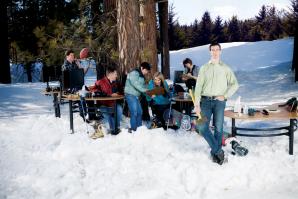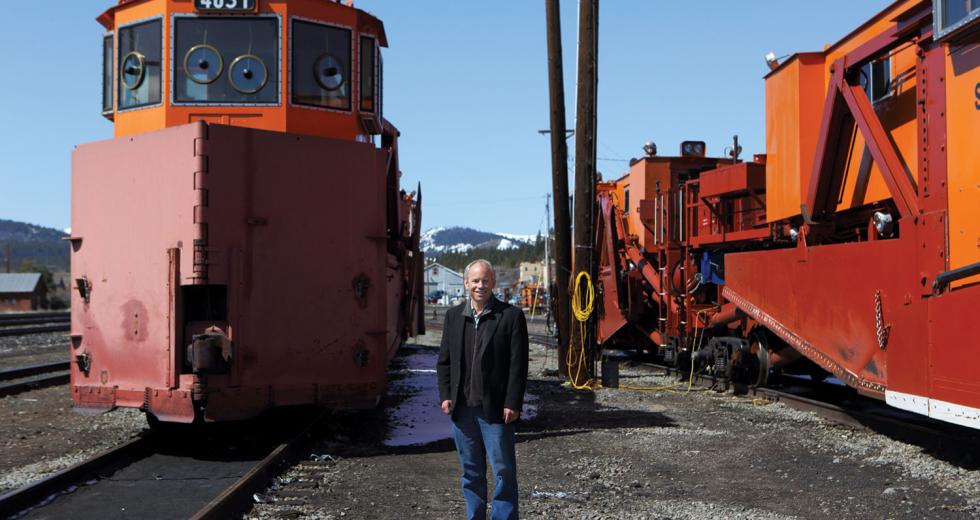A town long known for its quaint historic authenticity, Truckee in the past five years has evolved from a sleepy hamlet to a city with the promise of vibrancy. But it’s a town mostly seen through car windows or during a quick stop as people make their way to the famous lake and ski resorts beyond its boundary.
In marketing lingo, Truckee is the gateway to Tahoe’s North Shore. But plainly stated, it’s a base camp for its surroundings, and that’s the label the town is committed to with the redevelopment of its downtown railyard.
When first approved in June 2009, the Truckee Railyard project was to be the largest downtown development since the town’s founding in 1868. Despite its magnitude, the project received a concerted 5-0 vote of approval from the Town Council and overwhelming public support, including that of every living Truckee mayor, the Truckee Donner Railroad Society and the Truckee River Watershed Council.
Rarely does a project enjoy such broad public support, yet three years after approval, this one remains at a virtual standstill. There are “25 million” small problems in the way, and that’s only for phase one, which focuses on infrastructure.
For a town of about 20,000 people, $25 million is a hefty price tag for phase one, but it helps create a project the town almost unanimously thinks it needs — and deserves. No definitive price tag has been established for the rest of the development because it hasn’t been designed yet.
“Truckee is directly competing against the resorts — it’s important that we be able to offer the same amenities those resorts offer,” says Alyssa Thomas, president of the Truckee Downtown Merchants Association. “We want Truckee to not just be part of a trip, but the destination itself.”
It’s not enough that National Geographic Adventure recently named Truckee one of the world’s Top 25 Ski Towns. If anything, that has forced the competition to step up its game. Major corporations are investing hundreds of millions of dollars in the region. Purchases by Vail Resorts of Northstar California Resort (previously Northstar-at-Tahoe) and Kirkwood Mountain Resort, and KSL Resorts’ acquisition of Squaw Valley and Alpine Meadows are leading many to believe the north side of Tahoe soon will be compared to the ski meccas of Utah and Colorado.
Couple that kind of investment with a growing population, comprised largely of young, smart, successful people — which translates into new business growth — and all the signals show that Truckee must take steps now to prepare for a more robust and prospering economy if it doesn’t want to get left behind.
“This is a large, blighted property right in the center of our community, but there’s no reason it should stay that way,” says Truckee Mayor Joan Jones.
The original master plan envisioned three distinct districts encompassing 75 acres of commercial space, 30,000 square feet of office space, 250 hotel rooms and 100 new residential units, effectively doubling downtown Truckee’s size. Within that plan is the goal to meet local demand for a movie theater, a grocery store and, above all, more downtown residents. By creating a residential core, Jones says, the project would supplement an economy that currently relies on visitors, seasonal second homeowners and locals who enjoy an occasional night out.
About 75 percent of the approved space is for residential projects, says Rick Holliday, president of Holliday Development, the project’s primary developer.
“This site can be a tremendous asset for housing and commercial activities that will create much more of a year-round economy for the town,” Jones says. “That, of course, offers substantial economic benefits for everyone.”
It was originally thought that much of the $25 million needed for phase one would come from a local redevelopment agency. But in a now familiar narrative, that funding source was eliminated under 2011 legislation.
“We’ve got a poster child of smart growth and planning, yet in
our wisdom as a state we eliminated one of the best tools that
could get this project started,” says Tony Lashbrook, Truckee’s
town manager. “When that legislation was upheld by a state
Supreme Court decision, we were suddenly facing a worst-case
scenario.”
“I’ve been in local government for 31 years, and I’ve never seen the kind of community support for development that I have for this railyard.”
Tony Lashbrook, manager, town of Truckee
That scenario was exacerbated by the town’s unsuccessful bid to get funds from a state money pool created in 2006 by the sale of Proposition 1C bonds, which, among other things, were designed to support construction of affordable housing.
With a $25 million hole to fill, finding new sources of capital has become the principal focus of the town and the Truckee Railyard Partnership. Efforts resumed to acquire Prop 1C funds, and proponents have submitted a grant request to the federal Transportation Investment Generating Economic Recovery grant program which, as part of the American Recovery and Reinvestment Act, awards grants for investment in surface transportation projects that “will have significant impact on the nation, a metropolitan area or a region.”
There also is discussion of scaling down phase one of the project — something supporters are calling “infrastructure light.”
“That’s about $5 million worth of infrastructure,” Lashbrook says. “The key is to determine what kind of development from there would make the most sense — what is the right use to attract energy and people downtown. Current ideas include a movie theater and housing adjacent to the downtown area.”
The reduced plan, which would involve some roadwork and a deal with a theater operator, is being shopped to potential partners. That effort is showing promise, and in recent weeks a new idea has emerged that could sweeten the deal.
“There’s a performing arts project that may make sense to be part of the movie theater project,” Holliday says. “We’re going to conduct a feasibility study to see if we can move the housing to a separate block and have the arts and movie theaters together on the same block, giving the town a dedicated arts corner.”
Implementing a scaled back program won’t diminish the project’s broader infrastructure needs, which Mayor Jones describes as “unusual.” Two of the biggest issues include the “Balloon Track” and Trout Creek.
The Balloon Track, a loop of railroad track owned by Union Pacific, was built in 1901 to facilitate the turning of snowplow trains. It’s in the way and must be moved to the eastern end of the site. The hardest part of that process — negotiating a deal with the Union Pacific — has already been accomplished. With that agreement in place, funding is the only obstacle left for the relocation.
Trout Creek is a slightly different story. As the key watershed feature on the site, it’s pinched between the Balloon Track and the highway, and it puts the project site squarely in the 100-year flood plain. Given that the area has already flooded twice in the past 30 years, it’s not a problem that can be easily overlooked. Moving the Balloon Track would help ease that constraint, but additional restoration and other efforts to minimize the risk of flood damage are required.
Despite the setbacks in the four years since the project was first approved, progress has been made. Some construction, however small, is complete. One small building stands west of the railyard, serving as a model of the mixed-use development envisioned, as well as the look and feel of the architectural design. It even has a tenant, a local baker who moved in in May.
It’s a small start, but it’s also evidence the town has not given up its dream. The demise of the original financing plans is an impediment, but not something that would stop the project, say supporters, who continue to explore options.
“From the start, this project has been a great match for our town’s planning principals, and it continues to have a lot of momentum behind it,” Lashbrook says. “The most common question I get is, ‘When is it going to get started?’ ”
That is a question with no easy answer. In the best case, requiring some moon-and-stars alignment, infrastructure improvements could start in summer 2013 and be complete before the end of that year. The worst-case scenario is that the project never gets built. In the meantime, the project continues to receive broad public support.
“I’ve been in local government for 31 years, and I’ve never seen the kind of community support for development that I have for this railyard,” Lashbrook says. “It had great momentum until the economy and the redevelopment thing pulled the rug out. The positive energy is still there — we just need a little kick-start.”
Recommended For You

When the Walls Come Down
Clear Capital finds success in Tahoe's playground
When Kevin Marshall co-founded a real estate valuation firm in 2001, his first order of business was to bust down the walls.

Off the Reservation
A new bet on an old law
With fewer discretionary dollars in their pocketbooks and more sensitivity at the gas pump, recession-era gamblers want to spend their quarters closer to home.



